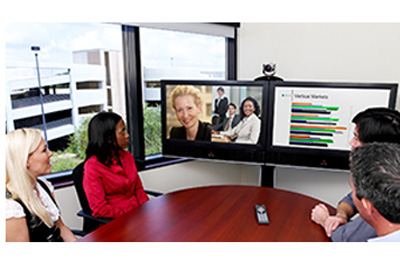
Business leaders 'opt for video conferencing'
Dubai, November 20, 2013
About 96 per cent of business decision makers believe video conferencing removes distance barriers and improves productivity between teams in difference cities and countries, said a survey.
The survey ‘Global View: Business Video Conferencing Usage and Trends’ was conducted by Redshift Research and commissioned by Polycom, a leader in open, standards-based unified communications and collaboration (UC&C).
It stated that video conferencing is an essential tool helping improve team collaboration and closing the physical and cultural gap between colleagues doing business across distances.
About 47 per cent of respondents chose video to be their preferred method of communication, after email and voice/conference calls. The same business leaders and managers expect video to be their most preferred collaboration tool in three years.
Respondents who use video conferencing said the three biggest advantages are better collaboration between globally dispersed colleagues (54 per cent), greater clarity of topics being discussed (45 per cent) and more efficient meetings (44 per cent).
Over three quarters of decision-maker respondents are now using video conferencing at work with 56 per cent of video users taking part in video calls at least once a week.
The survey found that in Brazil, India and Singapore, that number jumps up significantly, as more than two-thirds of respondents in those countries use video conferencing at least once a week.
It also revealed that about 83 per cent of respondents, and almost 90 per cent of those in their 20s and 30s, use consumer video conferencing solutions at home, and almost half of all respondents use video conferencing at home at least once a week.
“The growing popularity of video conferencing at home, especially by millennials entering the workforce, is a big driver of increased preference for and adoption of video collaboration in the workplace,” said Jim Kruger, EVP and chief marketing officer at Polycom.
“Some key factors to making video as popular in the office as it is at home is ensuring it’s easy to use, providing a high quality connection, delivering enterprise-grade security, and participants’ willingness to accept and adapt to cultural differences as they communicate across borders,” he said.
“We’re seeing businesses around the world defy distance every day using video collaboration, including increasing productivity, enhancing employee engagement, improving time to market and helping to save lives,” he added.
The study also showed that laptops and desktops are the most popular devices for business video conferencing (75 per cent of respondents), followed by conference rooms (48 per cent) and mobile devices (42 per cent).
The survey provided sharp insights from video conferencing users into which behaviours constitute an ideal video meeting, and which are distracting for business decision makers.
It found the top three most important criteria for an ideal video meeting are the ability to hear everyone clearly (69 per cent), technology that is straight forward and easy to use (60 per cent), and good eye contact with colleagues/ everyone is clearly visible (58 per cent).
The most distracting things, which should be avoided during video meetings, are mobile phone going off during a meeting, people attending from inappropriate places like public transit, in stores, people who are multi-tasking or look distracted, and inappropriate background distractions such as colleagues, music and noise.
Respondents from India, Singapore and Poland topped the list when asked if people not wearing business attire was a distraction, whereas less than 13 per cent of respondents in the UK, France, Russia and the Netherlands found attire to be a distraction.
The US leads the way in leveraging video conferencing for recruitment and hiring, as 32 per cent of video respondents said they use or would use video for this purpose, followed by the AsiaPacific region at 28 per cent.
In the Europe, Middle-East and Africa (EMEA) region, respondents mostly used video conferencing to empower flexible working environments, which was cited as the second highest reason for using the technology, after “connecting with colleagues across the country.”
The survey also found that video users in various business functions utilised it differently. CEOs and founders rated flexible working and inter- office/local meetings (50 per cent each) as their top reasons they use or would use video conferencing, followed by international meetings, new business/sales and company/department meetings.
The marketing function used video collaboration the most with 64 per cent respondents using it at least weekly, following by IT/engineering and facilities. However, the HR function was the power user with 32 per cent indicating they use video conferencing daily, followed by sales executives.
About 97 per cent of the respondents said it is important to try and understand different country cultures when meeting using video conferencing, which 89 per cent called for etiquette rules to be established to help them better use video conferencing for business.
Polycom has launched its ‘Guide to Collaborating Across Borders,’ an insightful new guide designed to help readers understand the nuances of doing business across the globe. - TradeArabia News Service







